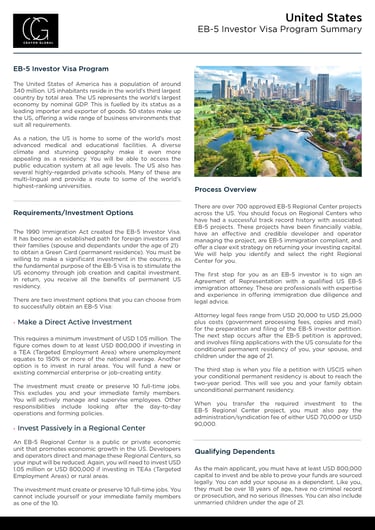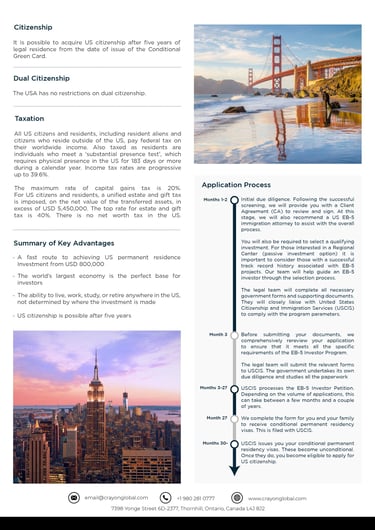United States EB-5
PERMANENT RESIDENCY
11/8/20252 min read





United States EB-5 Immigrant Investor Program
Residency is a function of capital allocation and job creation
The EB-5 Immigrant Investor Program offers a direct pathway to U.S. permanent residency — the coveted Green Card — through qualified investment and job creation. Created by the U.S. Congress in 1990 and modernized under the EB-5 Reform and Integrity Act of 2022, the program enables foreign investors and their families to gain lawful permanent residence by contributing to the growth of the U.S. economy.
Program Overview
The EB-5 Program is designed to stimulate economic growth through foreign capital. Investors obtain a Green Card by making a qualified investment in a new commercial enterprise (NCE) that creates or preserves at least 10 full-time U.S. jobs.
Applicants can invest directly in their own project or indirectly through USCIS-designated Regional Centers, which pool capital for large-scale developments and simplify compliance.
Once granted, the EB-5 visa provides permanent residency for the investor, spouse, and unmarried children under 21, with eligibility for U.S. citizenship after five years of residence.
Key Advantages
Permanent U.S. Residency: Obtain Green Cards for the entire family.
Citizenship Pathway: Eligible for naturalization after five years.
Education & Healthcare Access: Same benefits as other U.S. residents — world-class schools and medical care.
Freedom to Live, Work & Study Anywhere in the U.S.
No Sponsorship Required: The investor is self-sponsored; no employer or family petition needed.
Stable, Government-Backed Framework: Administered by U.S. Citizenship and Immigration Services (USCIS) under defined federal law.
Costs & Fees (Indicative)
Investment Amount: USD $800,000 – $1,050,000
Administrative Fee (Regional Center): USD $50,000 – $80,000 (varies by project)
Legal Fees: USD $15,000 – $25,000 (depending on structure)
USCIS Filing Fees:
Form I-526E: $11,160
Form I-829: $9,525
Due-Diligence & Escrow Costs: Typically additional $5,000 – $10,000
Additional Conditions:
The investment must be at risk for the purpose of job creation.
Must generate or preserve 10 full-time positions for U.S. workers within two years.
Funds must have a lawful source and path of funds (fully documented).
Eligible Investment Routes
Regional Center Investment
Most popular route (≈ 90% of applications).
Indirect job creation allowed.
Professionally managed projects (real estate, infrastructure, hospitality, logistics, etc.).
Lower administrative burden.
Direct Investment
Investor owns or operates the business directly.
Requires direct job creation and management oversight.
Greater control and potential return, but higher operational responsibility.
Process & Timeline
Select Project / Regional Center
Choose an approved EB-5 project or establish your own new commercial enterprise.Prepare Documentation & Invest
Transfer qualifying capital; document lawful source and transfer of funds.File Form I-526E (Regional Center) or I-526 (Direct)
USCIS reviews project compliance, source of funds, and job-creation plans.Conditional Green Card (2 Years)
Upon approval and visa issuance, the investor and family receive conditional permanent residency.Job Creation & Removal of Conditions (Form I-829)
After two years, demonstrate that the investment has met job-creation requirements to obtain unconditional Green Cards.Path to Citizenship
After five years of total U.S. residency, EB-5 investors may apply for U.S. citizenship.
Current Processing Times (2025)
I-526E (Regional Center): ~20 – 30 months (varies by nationality and priority date)
Visa Issuance (Consular): 3 – 6 months post-approval
I-829 (Condition Removal): 24 – 36 months
The EB-5 Reform and Integrity Act (RIA 2022) introduced priority processing for rural projects, with some cases approved in under 12 months.
Due Diligence & Risk Considerations
The investment must remain “at risk” until job-creation is achieved.
Returns are typically modest; EB-5 is a residency instrument, not a yield vehicle.
Investors should engage SEC-compliant Regional Centers and immigration-qualified counsel.
USCIS maintains strict scrutiny on source of funds, project compliance, and job-creation evidence.
Conclusion
The U.S. EB-5 Immigrant Investor Program is one of the world’s most established and institutionally regulated residency-by-investment frameworks. It delivers not only a Green Card, but a foundation for global family relocation, access to the U.S. education system, and eventual American citizenship. For investors seeking permanent optionality in the world’s largest economy, EB-5 remains the benchmark.
Contact us
Let’s design the structure your wealth actually deserves.
If you’re ready to move from reactive advisory to engineered advantage — start here.
Reach out and we’ll evaluate fit, then architect a plan built around your reality.
Contact
📍 7700 Hurontario St Unit 503, Brampton ON, L6Y 4M3 Canada
📞 +1 980 281 0777
✉️email@crayonglobal.com


©Crayon Global 2025. All rights reserved.
